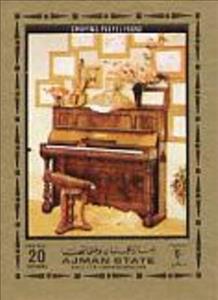Stamp: Pleyel Piano (Ajman 1972)
Pleyel Piano (Ajman 1972)
01 February (Ajman ) within release Frederic Chopin goes into circulation Stamp Pleyel Piano face value 20 United Arab Emirates dirham
| Stamp Pleyel Piano in catalogues | |
|---|---|
| Michel: | Mi: AJ 1323B |
Stamp is vertical format.
Also in the issue Frederic Chopin:
- Se-tenant - Frederic Chopin - se-tenant face value 180;
- Stamp - Aurore Dupin (George Sand), Auguste Charpentier (c. 1837) face value 15;
- Stamp - Cast of Chopin's Hand, Auguste Clésinger face value 40;
- Stamp - Chopin, Maria Wodzinska (1836) face value 25;
- Stamp - Chopin's Father & Mother face value 35;
- Se-tenant - Frederic Chopin - se-tenant face value 180;
- Stamp - Frédéric François Chopin, Ary Scheffer face value 10;
- Stamp - Frédéric François Chopin, Eugène Delacroix face value 5;
- Stamp - Frederick Chopin, Ludwig Nauer face value 30;
- Stamp - Pleyel Piano face value 20;
Stamp Pleyel Piano it reflects the thematic directions:
A musical instrument is a device created or adapted to make musical sounds. In principle, any object that produces sound can be considered a musical instrument—it is through purpose that the object becomes a musical instrument. A person who plays a musical instrument is known as an instrumentalist. The history of musical instruments dates to the beginnings of human culture. Early musical instruments may have been used for rituals, such as a horn to signal success on the hunt, or a drum in a religious ceremony. Cultures eventually developed composition and performance of melodies for entertainment. Musical instruments evolved in step with changing applications and technologies.
Painting is the practice of applying paint, pigment, color or other medium to a solid surface (support base). The medium is commonly applied to the base with a brush, but other implements, such as knives, sponges, and airbrushes, can be used. Painting is a mode of creative expression, and the forms are numerous. Drawing, gesture (as in gestural painting), composition, narration (as in narrative art), or abstraction (as in abstract art), among other aesthetic modes, may serve to manifest the expressive and conceptual intention of the practitioner. Paintings can be naturalistic and representational (as in a still life or landscape painting), photographic, abstract, narrative, symbolistic (as in Symbolist art), emotive (as in Expressionism), or political in nature (as in Artivism). A portion of the history of painting in both Eastern and Western art is dominated by spiritual motifs and ideas. Examples of this kind of painting range from artwork depicting mythological figures on pottery, to Biblical scenes rendered on the interior walls and ceiling of the Sistine Chapel, to scenes from the life of Buddha or other images of Eastern religious origin. In art, the term painting describes both the act and the result of the action. The support for paintings includes such surfaces as walls, paper, canvas, wood, glass, lacquer, clay, leaf, copper and concrete, and the painting may incorporate multiple other materials including sand, clay, paper, plaster, gold leaf, as well as objects. The term painting is also used outside of art as a common trade among craftsmen and builders.

